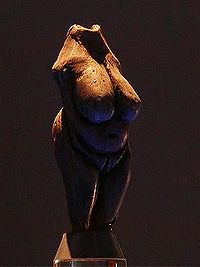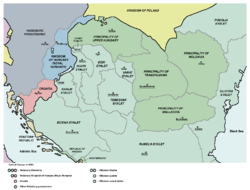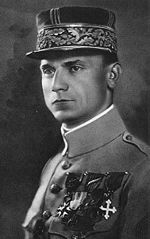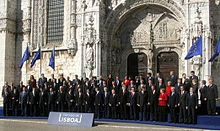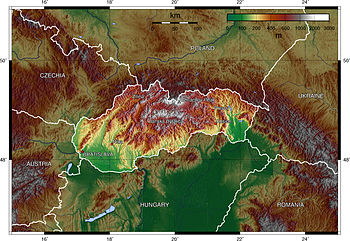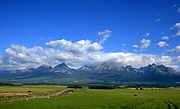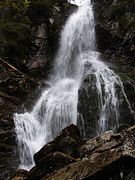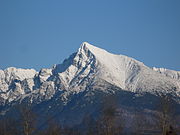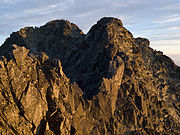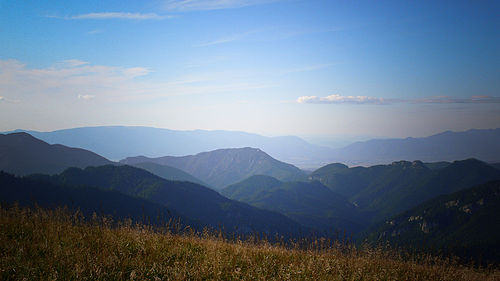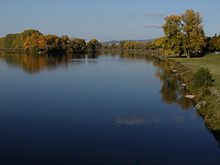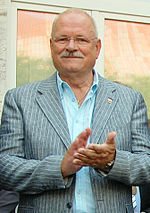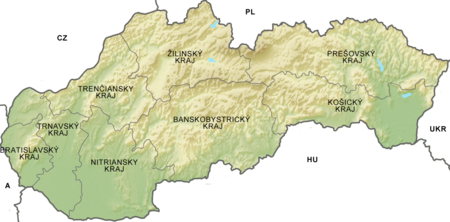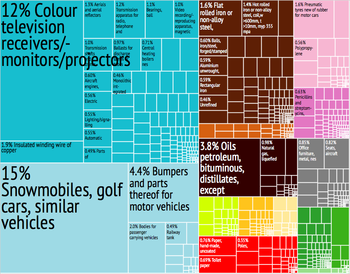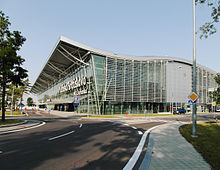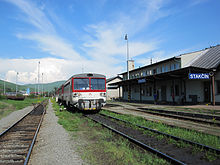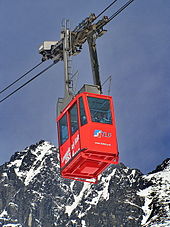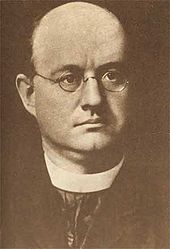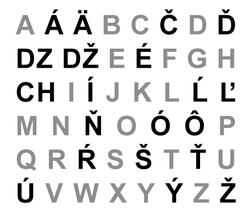
Slovakia
Background to the schools Wikipedia
This wikipedia selection has been chosen by volunteers helping SOS Children from Wikipedia for this Wikipedia Selection for schools. See http://www.soschildren.org/sponsor-a-child to find out about child sponsorship.
| Slovak Republic Slovenská republika
|
||||||
|---|---|---|---|---|---|---|
|
||||||
| Anthem: Nad Tatrou sa blýska Lightning Over the Tatras |
||||||
|
Location of Slovakia (dark green)
– in Europe (green & dark grey) |
||||||
| Capital and largest city |
Bratislava 48°09′N 17°07′E |
|||||
| Official languages | Slovak | |||||
| Ethnic groups (2011) |
|
|||||
| Demonym | Slovak | |||||
| Government | Parliamentary republic | |||||
| - | President | Ivan Gašparovič | ||||
| - | Prime Minister | Robert Fico | ||||
| Legislature | National Council | |||||
| Independence | ||||||
| - |
from Austria–Hungary
(as part of Czechoslovakia) |
28 October 1918 | ||||
| - | from Czechoslovakia | 1 January 1993a | ||||
| Area | ||||||
| - | Total | 49,035 km2 ( 129th) 18,932 sq mi |
||||
| - | Water (%) | negligible | ||||
| Population | ||||||
| - | 2012 estimate | 5,410,836 ( 115th) | ||||
| - | 2011 census | 5,397,036 | ||||
| - | Density | 111/km2 ( 88th) 287/sq mi |
||||
| GDP ( PPP) | 2012 estimate | |||||
| - | Total | $132.384 billion | ||||
| - | Per capita | $24,284 | ||||
| GDP (nominal) | 2012 estimate | |||||
| - | Total | $91.186 billion | ||||
| - | Per capita | $16,726 | ||||
| Gini (2005) | 26 low |
|||||
| HDI (2012) | very high · 35th |
|||||
| Currency | Euro ( €)b ( EURb) |
|||||
| Time zone | CET ( UTC+1) | |||||
| - | Summer ( DST) | CEST ( UTC+2) | ||||
| Drives on the | right | |||||
| Calling code | +421c | |||||
| ISO 3166 code | SK | |||||
| Internet TLD | .skd | |||||
| a. | Czechoslovakia split into the Czech Republic and Slovakia; see Velvet Divorce. | |||||
| b. | Slovak koruna before 2009. | |||||
| c. | Shared code 42 with Czech Republic until 1997. | |||||
| d. | Also .eu, shared with other European Union member states. | |||||
The Slovak Republic (or, in short form, Slovakia / s l oʊ ˈ v ɑː k i ə / or / s l ə ˈ v æ k i ə /; Slovak: ![]() Slovensko ( help·info), long form
Slovensko ( help·info), long form ![]() Slovenská republika ( help·info)) is a landlocked state in Central Europe.It has a population of over five million and an area of about 49,000 square kilometres (19,000 sq mi). Slovakia is bordered by the Czech Republic and Austria to the west, Poland to the north, Ukraine to the east and Hungary to the south. The largest city is the capital, Bratislava, and the second largest is Košice. Slovakia is a member state of the European Union, NATO, United Nations, OECD and WTO among others. The official language is Slovak, a member of the Slavic language family.
Slovenská republika ( help·info)) is a landlocked state in Central Europe.It has a population of over five million and an area of about 49,000 square kilometres (19,000 sq mi). Slovakia is bordered by the Czech Republic and Austria to the west, Poland to the north, Ukraine to the east and Hungary to the south. The largest city is the capital, Bratislava, and the second largest is Košice. Slovakia is a member state of the European Union, NATO, United Nations, OECD and WTO among others. The official language is Slovak, a member of the Slavic language family.
The Slavs arrived in the territory of present-day Slovakia in the 5th and 6th centuries during the migration period. In the course of history, various parts of today's Slovakia belonged to Samo's Empire (the first known political unit of Slavs), Principality of Nitra (as independent polity, as part of Great Moravia and as part of Hungarian Kingdom), Great Moravia, Kingdom of Hungary, the Austro-Hungarian Empire or Habsburg Empire, and Czechoslovakia. A separate Slovak state briefly existed during World War II, during which Slovakia was a dependency of Nazi Germany between 1939 and 1944. From 1945 Slovakia once again became a part of Czechoslovakia. The present-day Slovakia became an independent state on 1 January 1993 after the peaceful dissolution of Czechoslovakia.
Slovakia is a high-income advanced economy with one of the fastest growth rates in the European Union and the OECD. The country joined the European Union in 2004 and the Eurozone on 1 January 2009. Slovakia together with Slovenia and Estonia are the only former Communist states to be part of the European Union, Eurozone, Schengen Area and NATO simultaneously.
History
Radiocarbon dating puts the oldest surviving archaeological artifacts from Slovakia – found near Nové Mesto nad Váhom – at 270,000 BC, in the Early Paleolithic era. These ancient tools, made by the Clactonian technique, bear witness to the ancient habitation of Slovakia.
Other stone tools from the Middle Paleolithic era (200,000 – 80,000 BC) come from the Prévôt (Prepoštská) cave near Bojnice and from other nearby sites. The most important discovery from that era is a Neanderthal cranium (c. 200,000 BC), discovered near Gánovce, a village in northern Slovakia.
Archaeologists have found prehistoric Homo sapiens skeletons in the region, as well as numerous objects and vestiges of the Gravettian culture, principally in the river valleys of Nitra, Hron, Ipeľ, Váh and as far as the city of Žilina, and near the foot of the Vihorlat, Inovec, and Tribeč mountains, as well as in the Myjava Mountains. The most well-known finds include the oldest female statue made of mammoth-bone (22,800 BC), the famous Venus of Moravany. The statue was found in the 1940s in Moravany nad Váhom near Piešťany. Numerous necklaces made of shells from Cypraca thermophile gastropods of the Tertiary period have come from the sites of Zákovská, Podkovice, Hubina, and Radošinare. These findings provide the most ancient evidence of commercial exchanges carried out between the Mediterranean and Central Europe.
Bronze age
The Bronze Age in Slovakia went through three stages of development, stretching from 2000 to 800 BC. Major cultural, economic, and political development can be attributed to the significant growth in production of copper, especially in central Slovakia (for example in Špania Dolina) and northwest Slovakia. Copper became a stable source of prosperity for the local population.
After the disappearance of the Čakany and Velatice cultures, the Lusatian people expanded building of strong and complex fortifications, with the large permanent buildings and administrative centers. Excavations of Lusatian hill forts document the substantial development of trade and agriculture at that period. The richness and the diversity of tombs increased considerably. The inhabitants of the area manufactured arms, shields, jewelry, dishes, and statues.
The arrival of tribes from Thrace disrupted the people of the Calenderberg culture, who lived in the hamlets located on the plain ( Sereď), and also in the hill forts located on the summits ( Smolenice, Molpí). The local power of the "Princes" of the Hallstatt culture disappeared in Slovakia during the last period of the Iron Age after strife between the Scytho-Thracian people and the Celtic tribes, who advanced from the south towards the north, following the Slovak rivers.
From around 500 BC, the territory of modern-day Slovakia was settled by Celts, who built powerful oppida on the sites of modern-day Bratislava and Havránok. Biatecs, silver coins with the names of Celtic Kings, represent the first known use of writing in Slovakia. From 2 AD, the expanding Roman Empire established and maintained a series of outposts around and just north of the Danube, the largest of which were known as Carnuntum (whose remains are on the main road halfway between Vienna and Bratislava) and Brigetio (present-day Szöny at the Slovak-Hungarian border).
Radiocarbon dating Near the northernmost line of the Roman hinterlands, the Limes Romanus, there existed the winter camp of Laugaricio (modern-day Trenčín) where the Auxiliary of Legion II fought and prevailed in a decisive battle over the Germanic Quadi tribe in 179 AD during the Marcomannic Wars. The Kingdom of Vannius, a kingdom founded by the Germanic Suebian tribes of Quadi and Marcomanni, as well as several small Germanic and Celtic tribes, including the Osi and Cotini, existed in Western and Central Slovakia from 8–6 BC to 179 AD.
Great invasions from the 4th to 7th century
In the 2nd and 3rd centuries AD the Huns began to leave the Central Asian steppes. They crossed the Danube in 377 AD and occupied Pannonia, which they used for 75 years as their base for launching looting-raids into Western Europe. However, Attila's death in 453 brought about the disappearance of the Hun tribe. In 568 a Turko-Mongol tribal confederacy, the Avars, conducted their own invasion into the Middle Danube region. The Avars occupied the lowlands of the Pannonian Plain, established an empire dominating the Carpathian Basin.
In 623, the Slavic population living in the western parts of Pannonia seceded from their empire after a revolution led by Samo, a Frankish merchant. After 626 the Avar power started to gradually decline but their reign lasted to 804.
Slavic states
The Slavic tribes settled in the territory of present-day Slovakia in the 5th century. Western Slovakia was the centre of Samo's empire in the 7th century. A Slavic state known as the Principality of Nitra arose in the 8th century and its ruler Pribina had the first known Christian church of Slovakia consecrated by 828. Together with neighboring Moravia, the principality formed the core of the Great Moravian Empire from 833. The high point of this Slavonic empire came with the arrival of Saints Cyril and Methodius in 863, during the reign of Prince Rastislav, and the territorial expansion under King Svätopluk I.
Great Moravia (830–896 AD)

Great Moravia arose around 830 when Moimír I unified the Slavic tribes settled north of the Danube and extended the Moravian supremacy over them. When Mojmír I endeavoured to secede from the supremacy of the king of East Francia in 846, King Louis the German deposed him and assisted Moimír's nephew, Rastislav (846–870) in acquiring the throne. The new monarch pursued an independent policy: after stopping a Frankish attack in 855, he also sought to weaken influence of Frankish priests preaching in his realm. Rastislav asked the Byzantine Emperor Michael III to send teachers who would interpret Christianity in the Slavic vernacular.
Upon Rastislav's request, two brothers, Byzantine officials and missionaries Saints Cyril and Methodius came in 863. Cyril developed the first Slavic alphabet and translated the Gospel into the Old Church Slavonic language. Rastislav was also preoccupied with the security and administration of his state. Numerous fortified castles built throughout the country are dated to his reign and some of them (e.g., Dowina, sometimes identified with Devín Castle) are also mentioned in connection with Rastislav by Frankish chronicles.
During Rastislav's reign, the Principality of Nitra was given to his nephew Svatopluk as an appanage. The rebellious prince allied himself with the Franks and overthrew his uncle in 870. Similarly to his predecessor, Svatopluk I (871–894) assumed the title of the king (rex). During his reign, the Great Moravian Empire reached its greatest territorial extent, when not only present-day Moravia and Slovakia but also present-day northern and central Hungary, Lower Austria, Bohemia, Silesia, Lusatia, southern Poland and northern Serbia belonged to the empire, but the exact borders of his domains are still disputed by modern authors. Svatopluk also withstood attacks of the semi-nomadic Magyar tribes and the Bulgarian Empire, although sometimes it was he who hired the Magyars when waging war against East Francia.
In 880, Pope John VIII set up an independent ecclesiastical province in Great Moravia with Archbishop Methodius as its head. He also named the German cleric Wiching the Bishop of Nitra.
After the death of King Svatopluk in 894, his sons Mojmír II (894–906?) and Svatopluk II succeeded him as the King of Great Moravia and the Prince of Nitra respectively. However, they started to quarrel for domination of the whole empire. Weakened by an internal conflict as well as by constant warfare with Eastern Francia, Great Moravia lost most of its peripheral territories.
In the meantime, the semi-nomadic Magyar tribes, possibly having suffered defeat from the similarly nomadic Pechenegs, left their territories east of the Carpathian Mountains, invaded the Carpathian Basin and started to occupy the territory gradually around 896. Their armies' advance may have been promoted by continuous wars among the countries of the region whose rulers still hired them occasionally to intervene in their struggles.
We do not know what happened with both Mojmír II and Svatopluk II because they are not mentioned in written sources after 906. In three battles (4–5 July and 9 August 907) near Bratislava, the Magyars routed Bavarian armies. Some historians put this year as the date of the breakup of the Great Moravian Empire, due to the Hungarian conquest; other historians take the date a little bit earlier (to 902).
Great Moravia left behind a lasting legacy in Central and Eastern Europe. The Glagolitic script and its successor Cyrillic were disseminated to other Slavic countries, charting a new path in their sociocultural development. The administrative system of Great Moravia may have influenced the development of the administration of the Kingdom of Hungary.
Kingdom of Hungary (1000–1919)
Following the disintegration of the Great Moravian Empire at the turn of the 10th century, the Hungarians annexed the territory comprising modern Slovakia. From the 11th century, when the territory inhabited by the Slovak-speaking population of Danubian Basin was incorporated into the Kingdom of Hungary, until 1918, when the Austro-Hungarian empire collapsed, the territory of modern Slovakia was an integral part of the Hungarian state. The ethnic composition became more diverse with the arrival of the Carpathian Germans in the 13th century, and the Jews in the 14th century.
A significant decline in the population resulted from the invasion of the Mongols in 1241 and the subsequent famine. However, in medieval times the area of the present-day Slovakia was characterized rather by burgeoning towns, construction of numerous stone castles, and the cultivation of the arts. In 1465, King Matthias Corvinus founded the Hungarian Kingdom's third university, in Pozsony (Bratislava), but it was closed in 1490 after his death.
Before the Ottoman Empire's expansion into Hungary and the occupation of Buda in 1541, the capital of the Kingdom of Hungary (under the name of Royal Hungary) moved to Pozsony (in Slovak: Prespork at that time, currently Bratislava). Pozsony became the capital city of the Royal Hungary in 1536. But the Ottoman wars and frequent insurrections against the Habsburg Monarchy also inflicted a great deal of devastation, especially in the rural areas. As the Turks withdrew from Hungary in the late 17th century, the importance of the territory comprising modern Slovakia decreased, although Pozsony retained its status as the capital of Hungary until 1848, when it was transferred to Buda.
During the revolution of 1848–49 the Slovaks supported the Austrian Emperor, hoping for independence from the Hungarian part of the Dual Monarchy, but they failed to achieve their aim. Thereafter relations between the nationalities deteriorated (see Magyarization), culminating in the secession of Slovakia from Hungary after World War I.
Czechoslovakia (1918-1939)
In 1918, Slovakia and the regions of Bohemia, Moravia, Silesia and Carpathian Ruthenia formed a common state, Czechoslovakia, with the borders confirmed by the Treaty of Saint Germain and Treaty of Trianon. In 1919, during the chaos following the breakup of Austria-Hungary, Czechoslovakia was formed with numerous Germans and Hungarians within the newly set borders. A Slovak patriot Milan Rastislav Štefánik (1880–1919), who helped organize Czechoslovak regiments against Austria-Hungary during the First World War, died in a plane crash. In the peace following the World War, Czechoslovakia emerged as a sovereign European state. It provided what were at the time rather extensive rights to its minorities and remained the only democracy in this part of Europe in the interwar period.
During the Interwar period, democratic Czechoslovakia was allied with France, and also with Romania and Yugoslavia ( Little Entente); however, the Locarno Treaties of 1925 left East European security open. Both Czechs and Slovaks enjoyed a period of relative prosperity. Not only was there progress in the development of the country's economy, but in culture and in educational opportunities as well. The minority Germans came to accept their role in the new country and relations with Austria were good. Yet the Great Depression caused a sharp economic downturn, followed by political disruption and insecurity in Europe.
Thereafter Czechoslovakia came under continuous pressure from the revisionist governments of Germany and Hungary. Eventually this led to the Munich Agreement of September 1938, which allowed Nazi Germany to partially dismember the country by occupying what was called the Sudetenland, a region with a German-speaking majority and bordering Germany and Austria. The remainder of "rump" Czechoslovakia was renamed Czecho-Slovakia and included a greater degree of Slovak political autonomy. Southern and eastern Slovakia, however, was claimed back by Hungary at the First Vienna Award of November 1938.
World War II
After the Munich Agreement and its Vienna Award, Nazi Germany threatened to annex part of Slovakia and allow the remaining regions to be partitioned by Hungary or Poland unless independence was declared. Thus, Slovakia seceded from Czecho-Slovakia in March 1939 and allied itself, as demanded by Germany, with Hitler's coalition. The government of the First Slovak Republic, led by Jozef Tiso and Vojtech Tuka, was strongly influenced by Germany and gradually became a puppet regime in many respects.
Most Jews were deported from the country and taken to German labor camps. Thousands of Jews, however, remained to labor in Slovak work camps in Sereď, Vyhne, and Nováky. Tiso, through the granting of presidential exceptions, has been credited with saving as many as 40,000 Jews during the war, although other estimates place the figure closer to 4,000 or even 1,000. Nevertheless, under Tiso's government, 83% of Slovakia's Jewish population, a total of 75,000 individuals, were murdered, though new estimates show increasing numbers of Jewish casualties, approximately 105,000 people. Tiso became the only European leader to actually pay Nazi authorities to deport his country's Jews.
After it became clear that the Soviet Red Army was going to push the Nazis out of eastern and central Europe, an anti-Nazi resistance movement launched a fierce armed insurrection, known as the Slovak National Uprising, near the end of summer 1944. A bloody German occupation and a guerilla war followed. The territory of Slovakia was liberated by Soviet and Romanian forces by the end of April 1945.
Communist party rule (1948-1989)
After World War II, Czechoslovakia was reconstituted and Jozef Tiso was hanged in 1947 for collaboration with the Nazis. More than 80,000 Hungarians and 32,000 Germans were forced to leave Slovakia, in a series of population transfers initiated by the Allies at the Potsdam Conference. This expulsion is still a source of tension between Slovakia and Hungary. Out of about 130,000 Carpathian Germans in Slovakia in 1938, by 1947 only some 20,000 remained.
Czechoslovakia came under the influence of the Soviet Union and its Warsaw Pact after a coup in 1948. The country was occupied by the Warsaw Pact forces (with the exception of Romania) in 1968, ending a period of liberalization under the leadership of Alexander Dubček. In 1969 Czechoslovakia became a federation of the Czech Socialist Republic and the Slovak Socialist Republic.
Establishment of the Slovak Republic (1992-)
The end of Communist rule in Czechoslovakia in 1989, during the peaceful Velvet Revolution, was followed once again by the country's dissolution, this time into two successor states. In July 1992 Slovakia, led by Prime Minister Vladimír Mečiar, declared itself a sovereign state, meaning that its laws took precedence over those of the federal government. Throughout the autumn of 1992, Mečiar and Czech Prime Minister Václav Klaus negotiated the details for disbanding the federation. In November the federal parliament voted to dissolve the country officially on 31 December 1992.
The Slovak Republic and the Czech Republic went their separate ways after 1 January 1993, an event sometimes called the Velvet Divorce. Slovakia has remained a close partner with the Czech Republic. Both countries cooperate with Hungary and Poland in the Visegrád Group. Slovakia became a member of NATO on 29 March 2004 and of the European Union on 1 May 2004. On 1 January 2009, Slovakia adopted the Euro as its national currency.
Geography
Slovakia lies between latitudes 47° and 50° N, and longitudes 16° and 23° E.
The Slovak landscape is noted primarily for its mountainous nature, with the Carpathian Mountains extending across most of the northern half of the country. Amongst these mountain ranges are the high peaks of the Fatra-Tatra Area (including Tatra mountains, Greater Fatra and Lesser Fatra), Slovak Ore Mountains, Slovak Central Mountains or Beskids. The largest lowland is the fertile Danubian Lowland in the southwest, followed by the Eastern Slovak Lowland in the southeast.
Tatra mountains
Tatras, with 29 peaks higher than 2,500 metres (8,202 ft) AMSL, are the highest mountain range in the Carpathian Mountains. Tatras occupy an area of 750 km² (290 mi²), of which the greater part (600 km²/232 mi²) lies in Slovakia. They are divided into several parts.
To the north, close to the Polish border, are the High Tatras which are a popular hiking and skiing destination and home to many scenic lakes and valleys as well as the highest point in Slovakia, the Gerlachovský štít at 2,655 metres (8,711 ft) and the country's highly symbolic mountain Kriváň. To the west are the Western Tatras with their highest peak of Rysy at 2,503 metres (8,212 ft) and to the east are the Belianske Tatras, smallest by area.
Separated from the Tatras proper by the valley of the Váh river are the Low Tatras, with their highest peak of Ďumbier at 2,043 metres (6,703 ft).
The Tatra mountain range is represented as one of the three hills on the coat of arms of Slovakia.
|
National Parks
There are nine national parks in Slovakia:
| Name | Established |
|---|---|
| Tatra National Park | 1949 |
| Low Tatras National Park | 1978 |
| Veľká Fatra National Park | 2002 |
| Slovak Karst National Park | 2002 |
| Poloniny National Park | 1997 |
| Malá Fatra National Park | 1988 |
| Muránska planina National Park | 1998 |
| Slovak Paradise National Park | 1988 |
| Pieniny National Park | 1967 |
Caves
Slovakia has hundreds of caves and caverns under its mountains, out of which 15 are open to the public. Most of the caves have stalagmites rising from the ground and stalactites hanging from above. There are currently five Slovak caves under UNESCO's World Heritage Site status. They are Dobšinská Ice Cave, Domica, Gombasek Cave, Jasovská Cave and Ochtinská Aragonite Cave. Other caves open to public include Belianska Cave, Demänovská Cave of Liberty, Demänovská Ice Cave or Bystrianska Cave
Rivers
Most of the rivers stem in Slovak mountains. Some are only passing through and the others make a natural border with surrounding countries (more than 620 kilometres (385 mi)). For example Dunajec (17 kilometres (11 mi)) to the north, Danube (172 kilometres (107 mi)) to the south or Morava (119 kilometres (74 mi)) to the West. The total length of the rivers on Slovak territory is 49,774 kilometres (30,928 mi).
The longest river in Slovakia is Váh (403 kilometres (250 mi)), the shortest is Čierna voda. Another importand and large rivers are Myjava, Nitra (197 kilometres (122 mi)), Orava, Hron (298 kilometres (185 mi)), Hornád (193 kilometres (120 mi)), Slaná (110 kilometres (68 mi)), Ipeľ (232 kilometres (144 mi), making the border with Hungary), Bodrog, Laborec, Latorica and Ondava.
The biggest volume of discharge in Slovak rivers is during spring, when the snow is melting from the mountains. The only exception is Danube, whose discharge is the biggest during summer when the snow is melting in the Alps. Danube is the largest river that flows through Slovakia.
Lakes
Climate
The Slovak climate lies between the temperate and continental climate zones with relatively warm summers and cold, cloudy and humid winters. There are almost no extremes below minimal −20 °C (−4 °F) or above maximal 37 °C (99 °F). The weather differs from the mountainous North to the plain South.
The warmest region is Bratislava and Southern Slovakia where the temperatures may rise up to 30 °C (86 °F) in summer, occasionally to 37 °C (99 °F). During night, the temperatures rise up to 20 °C (68 °F). The daily temperatures in winter average in the range of −5 °C (23 °F) up to 10 °C (50 °F). During night it may be freezing, but usually not below −10 °C (14 °F).
Summer in Northern Slovakia is usually mild with temperatures around 25 °C (77 °F) (less in the mountains). Winters are colder in the mountains, where the snow usually lasts until March or even April and the night temperatures go down to −20 °C (−4 °F) and sometimes even deeper.
Although it may get quite windy, tornadoes and hurricanes do not occur.
Biodiversity
Slovakia signed the Rio Convention on Biological Diversity on 19 May 1993, and became a party to the convention on 25 August 1994. It has subsequently produced a National Biodiversity Strategy and Action Plan, which was received by the convention on 2 November 1998.
The biodiversity of Slovakia comprises animals (such as annellids, arthropods, molluscs, nematodes and vertebrates), fungi ( Ascomycota, Basidiomycota, Chytridiomycota, Glomeromycota and Zygomycota), micro-organisms (including Mycetozoa), and plants.
Fungi
Over 4000 species of fungi have been recorded from Slovakia. Of these, nearly 1500 are lichen-forming species Some of these fungi are undoubtedly endemic, but not enough is known to say how many. Of the lichen-forming species, about 40% have been classified as threatened in some way. About 7% are apparently extinct, 9% endangered, 17% vulnerable, and 7% rare. The conservation status of non-lichen-forming fungi in Slovakia is not well documented, but there is a red list for its larger fungi.
Politics and government

Slovakia is a parliamentary democratic republic with a multi-party system. The last parliamentary elections were held on 10 March 2012 and two rounds of presidential elections took place on 21 March 2009 and 4 April 2009.
The Slovak head of state is the president (currently Ivan Gašparovič), elected by direct popular vote for a five-year term. Most executive power lies with the head of government, the prime minister (currently Robert Fico), who is usually the leader of the winning party, but he/she needs to form a majority coalition in the parliament. The prime minister is appointed by the president. The remainder of the cabinet is appointed by the president on the recommendation of the prime minister.
Slovakia's highest legislative body is the 150-seat unicameral National Council of the Slovak Republic (Národná rada Slovenskej republiky). Delegates are elected for a four-year term on the basis of proportional representation. Slovakia's highest judicial body is the Constitutional Court of Slovakia (Ústavný súd), which rules on constitutional issues. The 13 members of this court are appointed by the president from a slate of candidates nominated by parliament.
Slovakia has been a member state of the European Union and NATO since 2004. As a member of the United Nations (since 1993), Slovakia was, on 10 October 2005, elected to a two-year term on the UN Security Council from 2006 to 2007. Slovakia is also a member of WTO, OECD, OSCE, and other international organizations.
The Constitution of the Slovak Republic was ratified 1 September 1992, and became effective 1 January 1993). It was amended in September 1998 to allow direct election of the president and again in February 2001 due to EU admission requirements. The civil law system is based on Austro-Hungarian codes. The legal code was modified to comply with the obligations of Organization on Security and Cooperation in Europe (OSCE) and to expunge the Marxist-Leninist legal theory. Slovakia accepts the compulsory International Court of Justice jurisdiction with reservations.
The president is the head of state and the formal head of the executive, though with very limited powers. The president is elected by direct, popular vote under the two-round system for a five-year term.
Following National Council elections, the leader of the majority party or the leader of the majority coalition is usually appointed prime minister by the president. Cabinet appointed by the president on the recommendation of the prime minister has to receive the majority in the parliament.
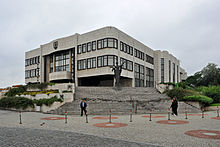
| Office | Name | Party | Since |
|---|---|---|---|
| President | Ivan Gašparovič | Movement for Democracy | 15 June 2004 |
| Prime Minister | Robert Fico | SMER-SD | 4 April 2012 |
| Speaker of the National Council of the Slovak Republic | Pavol Paška | SMER-SD | 4 April 2012 |
| Deputy Speakers of the National Council of the Slovak Republic | Jurinová Erika Ján Figeľ Jana Laššáková Renáta Zmajkovičová |
Obyčajní ľudia a nezávislé osobnosti KDH SMER-SD SMER-SD |
4 April 2012 4 April 2012 4 April 2012 4 April 2012 |
Foreign relations
The Slovak Republic has been a member of European Union since 2004. Slovakia has been an active participant in U.S.- and NATO-led military actions. There is a joint Czech-Slovak peacekeeping force in Kosovo.
The Slovak Republic is a member of the United Nations and participates in its specialized agencies. It is a member of the Organization for Security and Cooperation in Europe (OSCE), the World Trade Organization (WTO), and the OECD. It also is part of the Visegrad Four (Slovakia, Hungary, Czech Republic, and Poland), a forum for discussing areas of common concern.
The Slovak Republic and the Czech Republic entered into a Customs Union upon the division of Czechoslovakia in 1993, which facilitates a relatively free flow of goods and services. Slovak Republic maintains diplomatic relations with 134 countries, primarily through its Ministry of Foreign Affairs. There are 44 embassies and 35 honorary consulates in Bratislava.
Military
The Armed Forces of the Slovak Republic number 14,000 uniformed personnel. Slovakia joined NATO in March 2004. From 2006 the army transformed into a fully professional organization and compulsory military service was abolished.
Slovak Ground Forces are made up of two active mechanized infantry brigades. The Air and Air Defence Forces comprise one wing of fighters, one wing of utility helicopters, and one SAM brigade. Training and support forces comprise a National Support Element (Multifunctional Battalion, Transport Battalion, Repair Battalion), a garrison force of the capital city Bratislava, as well as a training battalion, and various logistics and communication and information bases. Miscellaneous forces under the direct command of the General Staff include the 5th Special Forces Regiment.
Human rights
The U.S. State Department in 2010 reported:
- "The government generally respected the human rights of its citizens; however, there were problems in some areas. Notable human rights problems included some continuing reports of police mistreatment of Romani suspects and lengthy pretrial detention; restrictions on freedom of religion; concerns about the integrity of the judiciary, corruption in national government, local government, and government health services; violence against women and children; trafficking in women and children; and societal discrimination and violence against Roma and other minorities."
Human rights in Slovakia are guaranteed by the Constitution of Slovakia from the year 1992 and by multiple international laws signed in Slovakia between 1948 and 2006. Slovakia excludes multiple citizenships.
Administrative divisions
As for administrative division, Slovakia is subdivided into 8 krajov (singular – kraj, usually translated as "region"), each of which is named after its principal city. Regions have enjoyed a certain degree of autonomy since 2002. Their self-governing bodies are referred to as Self-governing (or autonomous) Regions (sg. samosprávny kraj, pl. samosprávne kraje) or Upper-Tier Territorial Units (sg. vyšší územný celok, pl. vyššie územné celky, abbr. VÚC).
- Bratislava Region (Bratislavský kraj) (capital Bratislava)
- Trnava Region (Trnavský kraj) (capital Trnava)
- Trenčín Region (Trenčiansky kraj) (capital Trenčín)
- Žilina Region (Žilinský kraj) (capital Žilina)
- Prešov Region (Prešovský kraj) (capital Prešov)
- Nitra Region (Nitriansky kraj) (capital Nitra)
- Banská Bystrica Region (Banskobystrický kraj) (capital Banská Bystrica)
- Košice Region (Košický kraj) (capital Košice)
(the word kraj can be replaced by samosprávny kraj or by VÚC in each case)
The "kraje" are subdivided into many okresy (sg. okres, usually translated as districts). Slovakia currently has 79 districts.
In terms of economics and unemployment rate, the western regions are richer than eastern regions; however the relative difference is no bigger than in most EU countries having regional differences.
Economy
The Slovak economy is considered an advanced economy, with the country dubbed the " Tatra Tiger". Slovakia transformed from a centrally planned economy to a market-driven economy. Major privatizations are nearly complete, the banking sector is almost completely in private hands, and foreign investment has risen.
Before the global recession, Slovakia had experienced high and sustained economic growth. In 2007 (with the GDP growth of 10.5%), 2008 (with 5.8%) and 2010 (with 4.2%), Slovakia was the fastest growing economy in the European Union. In 2011 (with the GDP growth of 3.3%), Slovakia was the 2nd fastest growing Eurozone member (after Estonia). According to the European Economic Forecast, released by the European Commission in the spring 2012, Slovakia's predicted growth of 1.8% in 2012, will be the highest in the Eurozone and 4th highest in the EU-27.
Ratio of government debt to GDP in Slovakia is 41 percent, which is the fourth lowest in the Eurozone.
Unemployment, peaking at 19.2% at the end of 1999, decreased to 7.51% in October 2008 according to the Statistical Office of the Slovak Republic. In addition to economic growth, migration of workers to other EU countries also contributed to this reduction. According to Eurostat, which uses a calculation method different from that of the Statistical Office of the Slovak Republic, the unemployment rate in September 2012 is at 13.9% the third highest in the Eurozone (after Spain and Portugal).
Inflation dropped from an average annual rate of 12.0% in 2000 to just 3.3% in 2002, the election year, but it rose again in 2003–2004 because of rising labor costs and excess taxes. It reached only 1% in 2010 which is the lowest recorded rate since 1993. The ratio was at 3.9% in 2011.
Slovakia adopted the Euro currency on 1 January 2009 as the 16th member of the Eurozone. The euro in Slovakia was approved by the European commission on 7 May 2008. The Slovak koruna was revalued on 28 May 2008 to 30.126 for 1 euro, which was also the exchange rate for the euro.
Slovakia is an attractive country for foreign investors mainly because of its low wages, low tax rates and well educated labour force. In recent years, Slovakia has been pursuing a policy of encouraging foreign investment. FDI inflow grew more than 600% from 2000 and cumulatively reached an all-time high of $17.3 billion in 2006, or around $22,000 per capita by the end of 2008.
Despite a sufficient number of researchers and a decent secondary educational system, Slovakia, along with other post-communist countries, still faces major challenges in the field of the knowledge economy. The business and public research and development expenditures are well below the EU average. The Programme for International Student Assessment, coordinated by the OECD, currently ranks Slovak secondary education the 30th in the world (placing it just below the United States and just above Spain).
In March 2008, the Ministry of Finance announced that Slovakia's economy is developed enough to stop being an aid receiver from the World Bank. Slovakia became an aid provider at the end of 2008.
Industry
Although Slovakia's GDP comes mainly from the tertiary (services) sector, the industrial sector also plays an important role within its economy. The main industry sectors are car manufacturing and electrical engineering. Since 2007, Slovakia has been the world's largest producer of cars per capita, with a total of 571,071 cars manufactured in the country in 2007 alone. There are currently three automobile assembly plants: Volkswagen's in Bratislava, PSA Peugeot Citroën's in Trnava and Kia Motors' Žilina Plant.
From electrical engineering companies, Sony has a factory at Nitra for LCD TV manufacturing, Samsung at Galanta for computer monitors and television sets manufacturing.
ESET is an IT security company from Bratislava with more than 500 employees worldwide at present. Their branch offices are in the United States, Ireland, United Kingdom, Argentina, Czech Republic, Singapore and Poland.
Bratislava's geographical position in Central Europe has long made Bratislava a crossroads for international trade traffic. Various ancient trade routes, such as the Amber Road and the Danube waterway, have crossed territory of present-day Bratislava. Today, Bratislava is the road, railway, waterway and airway hub.
Transportation
Bratislava is a large international motorway junction: The D1 motorway connects Bratislava to Trnava, Nitra, Trenčín, Žilina and beyond, while the D2 motorway, going in the north-south direction, connects it to Prague, Brno and Budapest in the north-south direction. The D4 motorway (an outer bypass), which would ease the pressure on the city highway system, is mostly at the planning stage.
The A6 motorway to Vienna connects Slovakia directly to the Austrian motorway system and was opened on 19 November 2007.
Currently five bridges stand over the Danube (ordered by the flow of the river): Lafranconi Bridge, Nový Most (The New Bridge), Starý most (The Old Bridge), Most Apollo and Prístavný most (The Harbour Bridge).
The city's inner network of roadways is made on the radial-circular shape. Nowadays, Bratislava experiences a sharp increase in the road traffic, increasing pressure on the road network. There are about 200,000 registered cars in Bratislava, (approximately 2 inhabitants per car).
Bratislava's M. R. Štefánik Airport is the main international airport in Slovakia. It is located 9 kilometres (5.59 mi) northeast of the city centre. It serves civil and governmental, scheduled and unscheduled domestic and international flights. The current runways support the landing of all common types of aircraft currently used. The airport has enjoyed rapidly growing passenger traffic in recent years; it served 279,028 passengers in 2000, 1,937,642 in 2006 and 2,024,142 in 2007. Smaller airports served by passenger airlines include those in Košice and Poprad.
The Port of Bratislava is one of the two international river ports in Slovakia. The port connects Bratislava to international boat traffic, especially the interconnection from the North Sea to the Black Sea via the Rhine-Main-Danube Canal. Additionally, tourist lines operate from Bratislava's passenger port, including routes to Devín, Vienna and elsewhere.
Tourism
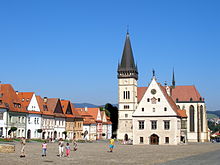
Slovakia features natural landscapes, mountains, caves, medieval castles and towns, folk architecture, spas and ski resorts. More than 1.6 million people visited Slovakia in 2006, and the most attractive destinations are the capital of Bratislava and the High Tatras. Most visitors come from the Czech Republic (about 26%), Poland (15%) and Germany (11%).
Typical souvenirs from Slovakia are dolls dressed in folk costumes, ceramic objects, crystal glass, carved wooden figures, črpáks (wooden pitchers), fujaras (a folk instrument on the UNESCO list) and valaškas (a decorated folk hatchet) and above all products made from corn husks and wire, notably human figures.
Souvenirs can be bought in the shops run by the state organization ÚĽUV (Ústredie ľudovej umeleckej výroby – Centre of Folk Art Production). Dielo shop chain sells works of Slovak artists and craftsmen. These shops are mostly found in towns and cities.
Prices of imported products are generally the same as in the neighboring countries, whereas prices of local products and services, especially food, are usually lower.
Science
Slovak Academy of Sciences has been the most important scientific and research institution in the country since 1953. Slovaks have made notable scientific and technical contributions during the history. The list of important scientists and their inventions include:
- Jozef Murgaš (1864 - 1929), contributed to development of wireless telegraphy
- Ján Bahýľ (1856 – 1916), constructed the first motor-driven helicopter (four years before Bréguet and Cornu)
- Štefan Banič (1870 - 1941), constructed the first actively used parachute
- Aurel Stodola (1859 - 1942), created a bionic arm in 1916 and pioneered steam and gas turbines
- John Dopyera (1893 – 1988), constructed a resonator guitar, an important contribution to the development of acoustic string instrument
- Eugen Čerňan (1934), American astronaut of Slovak origin was the last man to visit the Moon
- Ivan Bella (1964), first Slovak in space, having participated in a 9-day joint Russian-French-Slovak mission on the space station Mir in 1999.
- Daniel Gajdusek (1923 – 2008), (of Slovak ancestry) won the Nobel Prize in Physiology or Medicine in 1976 for work on kuru
- David Politzer (1949), winner of the Nobel Prize in Physics is also of Slovak ancestry.
Demographics
| Largest cities or towns of Slovakia Štatistický úrad Slovenskej republiky – 31 December 2011 |
|||||||||
|---|---|---|---|---|---|---|---|---|---|
| Rank | City name | Region | Pop. | Rank | City name | Region | Pop. | ||
 Bratislava |
1 | Bratislava | Bratislava Region | 462,603 | 11 | Prievidza | Trenčín Region | 48,866 |  Prešov |
| 2 | Košice | Košice Region | 240,688 | 12 | Zvolen | Banská Bystrica Region | 43,311 | ||
| 3 | Prešov | Prešov Region | 91,638 | 13 | Považská Bystrica | Trenčín Region | 41,153 | ||
| 4 | Žilina | Žilina Region | 81,515 | 14 | Michalovce | Košice Region | 39,940 | ||
| 5 | Banská Bystrica | Banská Bystrica Region | 79,775 | 15 | Nové Zámky | Nitra Region | 39,585 | ||
| 6 | Nitra | Nitra Region | 78,875 | 16 | Spišská Nová Ves | Košice Region | 37,948 | ||
| 7 | Trnava | Trnava Region | 66,219 | 17 | Humenné | Prešov Region | 34,913 | ||
| 8 | Martin | Žilina Region | 57,300 | 18 | Levice | Nitra Region | 34,649 | ||
| 9 | Trenčín | Trenčín Region | 55,832 | 19 | Komárno | Nitra Region | 34,478 | ||
| 10 | Poprad | Prešov Region | 52,791 | 20 | Bardejov | Prešov Region | 33,625 | ||
According to the 2011 census, the majority of the inhabitants of Slovakia are Slovaks (80.7%). Hungarians are the largest ethnic minority (8.5%). Other ethnic groups include Roma (2%), Czechs (0.6%), Rusyns (0.6%) and others or unspecified (7.6%). Unofficial estimates on the number of Roma population are much higher, around 9%. Before World War II, 135,000 Jews lived in Slovakia.
In 2007 Slovakia was estimated to have a total fertility rate of 1.33 (i.e., the average woman will have 1.33 children in her lifetime), which is significantly below the replacement level and is one of the lowest rates among EU countries.
The Slovaks endured the largest wave of emigration at the end of the 19th and the beginning of the 20th century. In the 1990 U.S. census, 1.8 million people identified themselves as being of Slovak ancestry.
Languages
The official language is Slovak, a member of the Slavic language family. Hungarian is widely spoken in the southern regions and Rusyn is used in some parts of the Northeast. Minority languages hold co-official status in the municipalities in which the size of the minority population meets the legal threshold of 20%.
Slovakia is ranked among the top EU countries regarding the knowledge of foreign languages. In 2007, 68% of the population aged from 25 to 64 years admitted speaking two or more foreign languages, finishing 2nd highest in the European Union. The best known foreign language in Slovakia is Czech. Eurostat report also shows that 98.3% of Slovak students in the upper secondary education take on two foreign languages, ranking highly over the average 60.1% in the European Union.
Religion
The Slovak constitution guarantees freedom of religion. In 2011, 62.0% of Slovaks identified themselves as Roman Catholics, 5.9% as Protestants, 3.8% as Greek Catholics, 0.9% as Orthodox, 13.4% identified themselves as atheists and 10.6% did not answer the question about their belief. In 2004, about one third of the then church members regularly attended church services. The pre–World War II population of the country included an estimated 90,000 Jews (1.6% of the population). After the genocidal policies of the Nazi era, only about 2,300 Jews remain today (0.04% of the population).



![Location of Slovakia (dark green)– in Europe (green & dark grey)– in the European Union (green) — [Legend]](../../images/816/81662.png)
